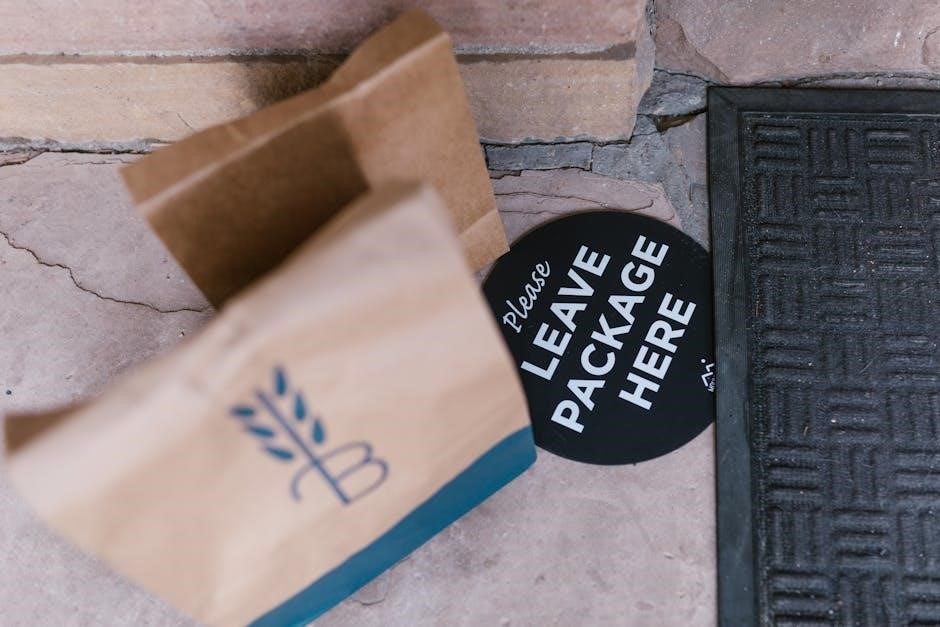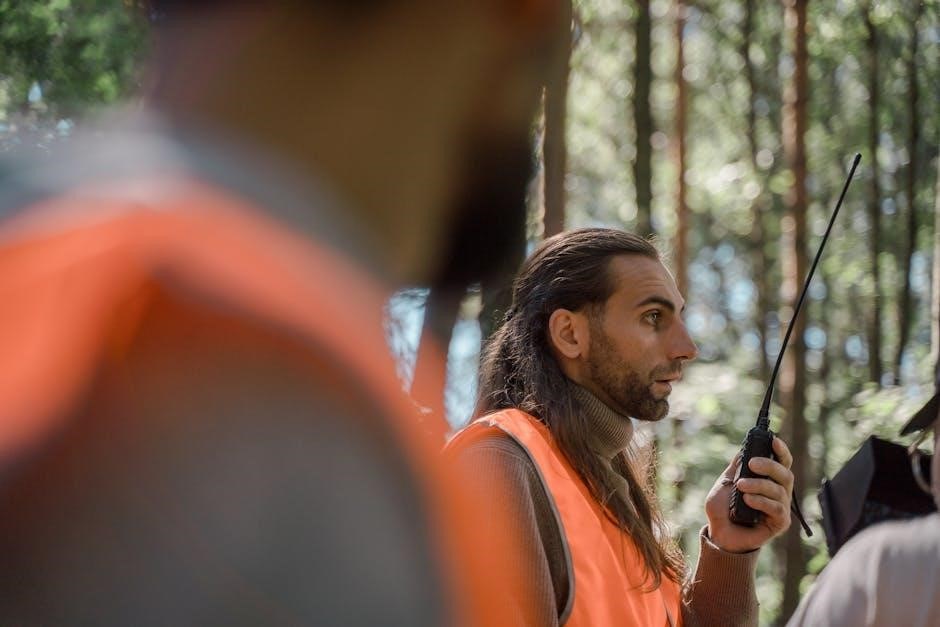K’NEX instructions provide essential guides for building various models, ensuring accuracy and creativity․ PDF formats offer clear step-by-step directions for both simple and complex constructions, enhancing the building experience․
1․1 Overview of K’NEX and Its Popularity
K’NEX is a classic construction toy consisting of rods, connectors, and other components that allow users to build intricate 3D models․ Its popularity stems from its versatility, encouraging creativity and problem-solving skills․ Suitable for all ages, K’NEX sets are widely used in education and hobbies, fostering STEM learning․ The availability of detailed PDF instructions has further enhanced its appeal, making complex builds accessible to beginners and experienced builders alike․ This has solidified K’NEX as a beloved tool for both fun and educational purposes․
1․2 Importance of Instructions in K’NEX Building
K’NEX instructions are vital for successful model construction, providing clear, step-by-step guidance․ They help users understand how to assemble components correctly, ensuring stability and functionality․ Without instructions, complex builds can become overwhelming, leading to errors or incomplete projects․ Instructions also highlight essential tips, such as proper connector usage and avoiding over-tightening, which are crucial for durability․ By following these guides, builders can achieve their desired results efficiently, making the process enjoyable and rewarding․ This emphasis on precision and clarity ensures that K’NEX instructions are indispensable for both beginners and experienced builders․
1․3 What to Expect in a K’NEX Instructions PDF
A K’NEX instructions PDF typically includes detailed, step-by-step guides for constructing specific models․ These documents feature diagrams, part lists, and assembly sequences, ensuring users can build complex structures like roller coasters or Ferris wheels․ The PDFs often provide tips to avoid common mistakes, such as miscounting pieces or incorrect assembly․ They may also include customization ideas for advanced builders․ Clear visuals and organized instructions make the process accessible for all skill levels, helping users achieve their creative vision effectively and efficiently․

Understanding the Basics of K’NEX Instructions
Understanding K’NEX basics is crucial for successful builds․ These sets include rods, connectors, and detailed PDF instructions to guide users in constructing diverse models effectively․
2․1 What Is K’NEX?
K’NEX is a popular construction toy consisting of interlocking rods and connectors․ It allows users to build complex 3D structures, fostering creativity and problem-solving skills․ Often used in educational settings, K’NEX helps develop STEM concepts․ The versatility of K’NEX makes it suitable for various age groups, from simple models for children to intricate designs for adults․ The toy is known for its durability and precision engineering, enabling users to create everything from roller coasters to bridges․ PDF instructions are commonly provided to guide users in constructing specific models, ensuring accuracy and ease of assembly․
2․2 Essential Components of K’NEX Sets
K’NEX sets include rods, connectors, wheels, and other specialized parts․ These components are designed for interlocking, allowing users to create dynamic structures․ Rods come in various lengths, while connectors enable multiple building angles․ Wheels and gears add motion to models, enhancing functionality․ Some sets also include rubber bands for added flexibility․ These components, combined with detailed PDF instructions, make it easier to assemble complex models․ Essential for both beginners and experienced builders, they provide the foundation for imaginative and educational projects․
2․3 The Role of PDF Instructions in K’NEX Building
K’NEX PDF instructions serve as vital guides for constructing models․ They provide detailed, step-by-step visuals and descriptions, ensuring accurate assembly․ These files are easily accessible and printable, making them convenient for builders․ PDFs often include diagrams and part lists, helping users organize components․ They cater to all skill levels, from simple projects to intricate designs․ By following these instructions, builders can achieve professional results and enjoy a seamless creative process․ PDF guides are indispensable for maximizing the K’NEX building experience․

Popular K’NEX Models and Their Instructions
K’NEX models range from roller coasters to ferris wheels, bridges, and amusement park designs․ Their instructions offer detailed guides for builders of all skill levels․
3․1 Roller Coasters
K’NEX roller coasters are a favorite among builders, offering thrilling designs with loops, drops, and curves․ PDF instructions provide detailed blueprints for models like the Rippin’ Roller Coaster, guiding enthusiasts through complex builds․ These plans include step-by-step assembly for tracks, supports, and themed elements․ Builders can customize heights and layouts, making each coaster unique․ Tips for stability and smooth motion ensure durable, functional creations․ Whether for beginners or advanced builders, K’NEX roller coaster instructions inspire creativity and precision, bringing amusement park excitement to life․
3․2 Ferris Wheels
K’NEX Ferris Wheels are classic builds that showcase rotational motion and structural balance․ Detailed PDF instructions guide builders through constructing sturdy bases, rotating axles, and passenger cars․ These models often feature adjustable heights and customizable gondolas․ Builders learn about gear mechanisms and symmetry while assembling․ Optional decorations, like lights or themed details, enhance the final design․ Ferris Wheels are ideal for those who enjoy blending engineering with creativity, offering a rewarding experience for both beginners and advanced builders․
3․3 Bridges
K’NEX bridges are iconic models that teach structural integrity and balance․ PDF instructions guide builders in creating arched, suspension, or beam bridges using rods and connectors․ These models often feature complex joints and supports, showcasing tension and compression principles․ Builders can customize bridge lengths and add details like guardrails or themed elements․ Instructions emphasize precise piece placement for stability, making bridges a great challenge for intermediate builders․ The end result is a durable, visually impressive structure that demonstrates engineering fundamentals in a fun way․
3․4 Towers and Skyscrapers
K’NEX towers and skyscrapers are challenging yet rewarding models that test balance and structural strength․ PDF instructions detail how to stack rods and connectors vertically, creating tall, stable structures․ These builds often require precise alignment and the use of spacers or clips to maintain stability․ Advanced models may incorporate intricate designs, such as rotating tops or multi-level frameworks․ Builders learn essential engineering principles while constructing these towering landmarks․ The step-by-step guides ensure even complex skyscrapers are achievable, making them a favorite among experienced K’NEX enthusiasts․
3․5 Amusement Park Models
K’NEX amusement park models, like roller coasters and Ferris wheels, are fan favorites for their dynamic and interactive designs․ PDF instructions provide detailed blueprints for constructing these intricate rides, ensuring accuracy and fun․ Builders can create spinning teacups, carousels, or even entire park layouts․ These models often incorporate moving parts, such as gears and pulleys, to simulate real-world motion․ With clear step-by-step guides, enthusiasts can bring their favorite amusement park attractions to life, fostering creativity and mechanical skills in the process․

Tools and Materials Needed for K’NEX Building
Essential tools include K’NEX rods, connectors, and optional wrenches for tighter builds․ A clean workspace and a PDF reader are also crucial for following instructions effectively․
4․1 Basic K’NEX Pieces
The foundation of any K’NEX project lies in its basic components․ These include rods of varying lengths, connectors that allow for angular adjustments, and spacers to maintain proper spacing․ Additionally, wheels and gears are essential for creating motion in models like roller coasters or cars․ These pieces are color-coded and standardized, ensuring compatibility across different sets․ Following the PDF instructions, builders can efficiently sort and assemble these parts to bring their creations to life․ Proper use of these components is key to achieving stability and functionality in every build․
4․2 Optional Tools for Advanced Builds
For complex K’NEX projects, optional tools can enhance precision and efficiency․ An Allen wrench or small screwdriver can tighten connections firmly, preventing loose joints․ Pliers may assist in bending or aligning stubborn rods․ A work surface with a built-in organizer can help sort pieces by type and size․ While not essential, these tools simplify the assembly process, especially for intricate models like roller coasters or bridges․ They allow for tighter connections and better organization, making advanced builds more manageable and enjoyable․ Proper tool use ensures stability and accuracy in every creation․
4․3 Workspace Requirements
A clean, stable, and well-lit workspace is crucial for K’NEX building․ Use a flat, sturdy table or surface to prevent pieces from rolling away․ Cover the area with a smooth, non-slip material like a tablecloth or mat to keep small parts organized․ Ensure good lighting to avoid eye strain while sorting and assembling components․ Keep all K’NEX pieces sorted by type and size in bins or trays to save time․ A stable environment reduces the risk of accidental knocks, especially when building tall structures․ Maintain a tidy workspace to avoid losing small parts, ensuring a smooth and enjoyable building process․

Step-by-Step Guide to Using K’NEX Instructions
Start by reviewing the entire PDF guide, understanding the model layout, and gathering all required pieces․ Follow each step methodically, ensuring accuracy for a successful build․
5․1 Reading and Interpreting the Instructions
Begin by carefully reviewing the PDF guide, ensuring you understand each step․ Pay attention to color-coded parts and symbols, which indicate specific rods, connectors, and actions․ Identify the required pieces for each stage to avoid mid-build shortages․ Familiarize yourself with diagrams, as they often show assembly from multiple angles․ Read descriptions thoroughly, noting any warnings or tips․ If unsure, cross-reference text with visuals to clarify․ Organize your workspace with all necessary components before starting for a smooth building process․
5․2 Sorting and Organizing Pieces
Before starting, sort and organize all K’NEX components to ensure a smooth building process․ Separate rods, connectors, wheels, and other small parts into categories․ Use small containers or bags to keep pieces tidy and accessible․ Identify spacers, as they are often crucial for stability and proper assembly․ Refer to the PDF guide to confirm the required pieces for each step․ Organizing your workspace beforehand prevents mid-build delays and ensures all components are within reach․ A well-prepared setup enhances focus and creativity during construction․
5․3 Following the Step-by-Step Instructions
Adhere closely to the PDF guide’s step-by-step instructions to assemble your K’NEX model accurately․ Each diagram and written instruction provides precise details for connecting rods and connectors․ Begin with the base structure, ensuring stability before adding complex elements․ Pay attention to specific alignment cues and part quantities․ Follow the sequence meticulously to avoid disassembly later․ Use visual cues in the guide to confirm each step․ Building methodically ensures a sturdy and functional final product, aligning with the design’s intended purpose and appearance․ Patience and attention to detail are key to success․
5․4 Tips for Building Complex Models
When tackling intricate K’NEX models, preparation and patience are crucial․ Start by thoroughly reviewing the PDF instructions to understand the overall structure․ Sort pieces by type to streamline assembly․ Use connectors and joints strategically to enhance flexibility and stability․ Incorporate motion elements like gears or motors for dynamic features․ For tall structures, add internal supports to prevent collapse․ Follow the guide closely but allow room for creativity․ Test components as you build to ensure functionality․ Regularly refer back to the instructions to avoid errors․ Stay organized and methodical to achieve a flawless, complex design․

Common Mistakes to Avoid
Common errors include miscounting pieces, misassembling components, and not following instructions closely․ Over-tightening rods can damage them, while ignoring safety tips risks accidents and injuries․
6․1 Miscounting Pieces
Miscounting pieces is a common mistake that can halt progress․ Always sort and count components before starting to ensure accuracy․ Double-checking quantities helps avoid missing parts midway, saving time and frustration․ Using a checklist or organizing pieces by type can prevent errors․ This step is crucial for complex models where each piece plays a vital role in stability and design․ Attention to detail ensures a smooth building process and a successful final product․
6․2 Incorrect Assembly of Components
Incorrectly assembling components can lead to unstable structures or models that don’t function as intended․ Always follow the sequence in the instructions precisely․ Ensure each part is connected properly, using the correct rods, connectors, and spacers․ Forgetting to secure joints tightly or over-tightening can cause damage․ Pay attention to visual cues in diagrams to align pieces accurately․ Taking time to review each step minimizes assembly errors, ensuring a sturdy and functional final product that matches the intended design․
6․3 Not Following the Instructions Closely
Not adhering to the instructions can result in incomplete or unstable models․ Always read each step carefully and ensure all parts are used as specified․ Skipping steps or deviating from the guide can lead to structural weaknesses or non-functional features․ Pay close attention to diagrams and part counts․ Double-checking your work as you go helps prevent errors․ Following the instructions closely ensures your K’NEX creation turns out as intended, maintaining both stability and functionality while achieving the desired design․
6․4 Over-Tightening or Over-Stretching Pieces
Over-tightening or over-stretching K’NEX pieces can cause permanent damage or breakage․ Use the recommended force to connect rods and connectors․ Applying excessive pressure may warp or snap components, rendering them unusable․ Ensure rubber bands are not over-stretched, as this can lead to wear and tear․ Proper handling ensures longevity of your K’NEX set and maintains the integrity of your builds․ Always handle pieces with care to avoid unnecessary stress on the materials․

Safety Tips for K’NEX Building
Handle small K’NEX parts with care to avoid choking hazards and eye injuries․ Use tools safely and avoid over-tightening pieces to prevent damage or breakage․

7․1 Handling Small Parts
Handling small K’NEX pieces requires caution to avoid accidents․ Always store parts in a secure, dry place and ensure they are out of reach of young children․ Small components can pose choking hazards, so adult supervision is recommended for builders under a certain age․ Clean and inspect pieces before use to avoid dirt or damage․ Use a tray or container to sort and organize parts, reducing the risk of loss or misplacement․ Never leave small pieces unattended or in areas where they could be easily misplaced or ingested․ Always check for loose parts before storing to ensure safety․
7․2 Avoiding Eye Injuries
Protecting your eyes is crucial while building with K’NEX․ Avoid using pieces that may spring back or snap unexpectedly, as this could cause eye injuries․ Wear protective eyewear if needed, especially during complex builds․ Ensure good lighting to see small parts clearly and avoid fatigue․ Never aim or propel pieces towards others or your own face․ Keep loose clothing tied back and long hair secured to prevent distractions․ Always handle rods and connectors with care, especially when removing or attaching them under tension․ Regularly inspect pieces for damage that could lead to sharp edges or points;
7․3 Using Tools Safely
Using tools safely is essential when building with K’NEX․ Always handle tools like wrenches, screwdrivers, or pliers with care to avoid accidents․ Ensure tools are used for their intended purpose and never force pieces together, as this can damage the tool or the K’NEX parts․ Keep tools out of reach of young children and store them properly after use․ Regularly inspect tools for damage or wear, and replace them if necessary․ Maintain a clean workspace to prevent tools from slipping or causing unintended injuries․
7․4 Building in a Stable Environment
Building in a stable environment is crucial for a successful K’NEX project․ Choose a flat, sturdy surface that can support the weight of your model․ Avoid areas prone to vibrations or movement, as this can disrupt your structure․ Ensure good lighting to see small pieces clearly and keep the workspace clean to prevent losing parts․ Secure loose clothing or jewelry that might get caught in the pieces․ For large models, consider assembling on a table or board that can be easily moved without damaging the structure․ This setup helps maintain focus and reduces the risk of accidents or damage to your creation․

Advanced K’NEX Building Techniques
Advanced techniques involve mastering connectors, joints, and motion elements․ These skills enhance stability, allow customization, and enable complex designs, taking your K’NEX creations to the next level․
8․1 Using Connectors and Joints
Connectors and joints are essential for creating stable and flexible K’NEX structures․ They allow rods to pivot or lock in place, enabling complex designs․ Proper alignment ensures durability and movement․ Using connectors strategically enhances the structural integrity of tall buildings or dynamic models like Ferris wheels․ Joints can be tightened or loosened to achieve the desired flexibility․ Following PDF guides helps master these elements, ensuring your creations stand sturdy and function smoothly․ Practice makes perfect in utilizing these critical components effectively․
8․2 Incorporating Motion and Movement
Incorporating motion into K’NEX models adds functionality and realism․ Gears, axles, and rubber bands are key components for creating movement․ PDF guides often detail how to align these parts for smooth operation․ For example, gears can drive rotational motion, while axles support wheels or moving arms․ Rubber bands add tension for mechanisms like catapults or swings․ Following instructions closely ensures proper assembly․ Experimenting with different configurations can bring dynamic elements to your creations, making them interactive and more engaging․ Motion enhances the creativity and fun of K’NEX building projects․
8․3 Adding Stability to Tall Structures
Building tall K’NEX structures requires careful attention to stability․ PDF guides often recommend using wide bases and balanced weight distribution․ Reinforcing joints with connectors can prevent wobbling․ Vertical supports, like rods or columns, enhance rigidity․ Anchoring the base on a flat surface ensures steadiness․ Regularly checking alignment during construction helps maintain balance․ Techniques like cross-bracing and using multiple anchor points can also strengthen tall models․ Following these tips ensures your structures stand tall without toppling, making them both durable and visually impressive․
8․4 Customizing Models
Customizing K’NEX models allows for personal creativity and uniqueness․ Users can modify designs by adding personalized colors, shapes, or themes․ PDF guides often provide inspiration and tips for alterations․ Experimenting with different rod lengths and connector placements can create distinctive features․ Incorporating additional pieces, like glow-in-the-dark rods, enhances visual appeal․ Themes like seasonal decorations or character designs can also be added․ Customization encourages creativity, making each model a one-of-a-kind project․ This approach fosters innovation and pride in your work, turning standard builds into extraordinary creations․

K’NEX Community and Resources
The K’NEX community offers extensive resources, including online forums, video tutorials, and official websites․ These platforms provide PDF guides, user-generated instructions, and tips for builders of all skill levels․
9․1 Online Forums and Communities
Online forums and communities are vibrant hubs for K’NEX enthusiasts to share ideas and resources․ Platforms like Reddit, Facebook groups, and specialized hobby forums host discussions, tips, and feedback․ Many users upload and download PDF instructions for custom models, fostering collaboration․ These communities also organize challenges and events, encouraging creativity and innovation․ Members often showcase their builds, providing inspiration and learning opportunities for others․ Engaging with these forums can enhance your building skills and connect you with fellow K’NEX fans worldwide․ Active participation helps troubleshoot issues and explore new techniques․
9․2 Video Tutorials and Guides
Video tutorials and guides complement K’NEX instructions PDF by offering visual step-by-step walkthroughs․ Platforms like YouTube feature extensive libraries of tutorials, covering builds from simple to complex․ These videos often include close-ups and narrated instructions, making intricate steps easier to follow․ Creators share tips for stability and customization, while time-lapse builds provide motivation․ Beginners benefit from slow-paced tutorials, while experienced builders can learn advanced techniques․ These resources enhance the learning process, ensuring a smoother and more enjoyable building experience․
9․3 Official K’NEX Websites and Downloads
Official K’NEX websites offer a wealth of resources, including downloadable PDF instructions for various models․ These sites provide access to classic set manuals, user guides, and exclusive content․ Users can easily find and download instructions for specific builds, ensuring authenticity and accuracy․ The official downloads are compatible with standard PDF readers like Adobe Acrobat․ This makes it convenient for builders to access detailed guides anytime, supporting both beginners and experienced enthusiasts in their creative projects․
9․4 User-Generated Instructions
User-generated K’NEX instructions are a valuable resource for builders, offering unique and creative models․ These PDF guides, shared by enthusiasts, cover a wide range of builds, from roller coasters to intricate machines․ Available on forums and community sites, they often include detailed photos and tips․ While not official, they provide fresh ideas and inspiration for builders of all skill levels․ This collaborative approach fosters a sense of community and encourages innovation, making user-generated content a popular choice for those seeking new challenges and designs to explore․
K’NEX instructions PDFs are essential guides for builders, sparking creativity and precision․ They empower users to construct intricate models, fostering learning and fun while mastering each design․
10․1 Summary of Key Points
K’NEX instructions PDFs are vital for successful builds, offering step-by-step guides for models like roller coasters and ferris wheels․ They ensure accuracy, creativity, and safety, while tools like Adobe Reader facilitate access; Avoiding mistakes, such as miscounting pieces or over-tightening, is crucial for stability․ The K’NEX community provides additional support through forums and user-generated content․ These resources empower builders of all skill levels to create intricate designs, fostering learning and enjoyment in every project․
10․2 Encouragement to Start Building
Embrace your creativity with K’NEX! Whether you’re a novice or an expert, K’NEX instructions PDFs offer clear guidance for all skill levels․ Start with simple models and gradually explore more complex designs․ Each build fosters problem-solving skills and patience․ Don’t hesitate to experiment and customize your creations․ The K’NEX community is full of inspiration and support, so dive in and enjoy the rewarding experience of bringing your ideas to life with every snap and connect․
10․3 Final Tips for Success
For a successful K’NEX building experience, always start by organizing your pieces and reading instructions carefully․ Use a flat, stable workspace and avoid over-tightening rods․ Patience is key—break complex models into smaller steps․ Regularly review your progress to ensure accuracy․ Don’t hesitate to seek help from online forums or video tutorials if stuck․ Embrace creativity and experiment with unique designs․ Most importantly, have fun and take pride in your creations․ Happy building!





